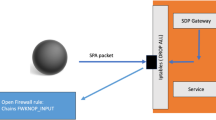Abstract
Network vulnerability analysis tools today do not provide a complete security awareness solution. Currently, network administrators utilize multiple analysis tools in succession or randomly in a patchwork fashion that provides only temporary assurance. This paper introduces NetGlean as a methodology for distributed network security scanning with a holistic approach to network analysis. NetGlean uses new and existing techniques in a continual, autonomous, evolutionary manner to provide powerful real-time and historical views of large and complex networks. This paper introduces the methodology and describes one implementation NetGleanIP, a scanner for IP and converged networks.
Similar content being viewed by others
References
Jeff Forristal and Greg Shipley, Vulnerability Assessment Scanners, Network Computing, January 8, 2001. http://www.nwc.com/1201/1201f1b1.html.
Fyodor, The Art of Port Scanning, www.insecure.org/nmap/nmap_doc.html, December 2, 2002.
Fyodor, Remote OS Detection via TCP/IP Stack FingerPrinting, http://www.insecure.org, April 10, 1999.
Thomas Ptacek and Timothy Newsham, Insertion, Evasion, and Denial of Service: Eluding Network Intrusion Detection, January 1998.
Richard Forno and Kenneth R. van Wyk, Incident Response. O’Reilly & Associates, Inc: August, 2001.
Kapil Sharma, Security Scanners, Linux Gazette, Issue 57. September 2000.
Blackburn Skaggs, Shenoi Manes, Network Vulnerability Analysis, Proceedings of the IEEE 45th Midwest Symposium on Circuits and Systems, Tulsa, OK, August 4–7, 2002.
J. Novotny, A. Meehan, D. Schulte, G. Manes, and S. Shenoi, Evidence Acquisition Tools for Cyber Sex Crimes Investigations, Proceedings of the SPIE Conference on Sensors and C3I Technologies for Homeland Defense and Law Enforcement (Vol. 4708), Orlando, Florida, April 2002.
Farrow, System Fingerprinting With Nmap, Network Magazine, November 5, 2000.
Arkin Ofir and Fyodor Yarochkin, Xprobe v2.0: A ‘Fuzzy’ Approach to Remote Active Operating System Fingerprinting. The Sys-Security Group, August 2002. http://www.sys-security.com.
Valeur Vigna, J. Zhou, and R. A. Kemmerer, Composable Tools For Network Discovery and Security Analysis, http://www.cs.ucsb.edu/~rsg/pub/2002_vigna_valeur_zhou_kemmerer_acsac02.pdf, November 20, 2002.
Arkin Ofir, ICMP Usage in Scanning. The Sys-Security Group, June 2001. http://www.sys-security.com.
Steve Gibson, The Strange Tale of the Denial of Service Attacks Against GRC.COM, Gibson Research Corporation: March 5, 2002.
Tom Harris, How Fingerprint Scanners Work, http://www.howstuffworks.com/fingerprint-scanner.htm, December 2, 2002.
El-Semary, A Framework for Network Intelligence and Security, Ph.D. Disseration, University of Tulsa, 2004.
Coretez Geovanni, Passive Mapping: An Offensive Use of IDS, Endeavor Systems, April 11, 2000.
Dawkins Manes and Shenoi Hale, Identifying & Tracking Attacks on Networks: C3I Displays & Related Technologies, Proceedings of the SPIE Conference on Sensors and C3I Technologies for Homeland Defense and Law Enforcement (Vol. 5071), Orlando, Florida, April 2003.
Nessus Information and Documentation. http://www.nessus.org/.
Nazario Jose, Passive System Fingerprinting using Network Client Applications, Crimelabs Research, January 19, 2001. http://www.crimelabs.net/docs/passive.pdf.
Author information
Authors and Affiliations
Corresponding author
Additional information
Gavin W. Manes is a Research Assistant Professor at the Center for Information Security and the University of Tulsa. His research interests are information assurance, digital forensics, telecommunications security, and critical infrastructure protection.
Dominic Schulte graduate with his Masters of Computer Science from the University of Tulsa in May 2003. Currently he works as an information security professional.
Seth Guenther graduate with his Masters of Computer Science from the University of Tulsa in May 2003. Currently he works as an information security professional.
Sujeet Shenoi is the F.P.Walter Professor of Computer Science at the University of Tulsa, Tulsa, Oklahoma. His research interests are in information assurance, digital forensics, critical infrastructure protection, and intelligent control.
Rights and permissions
About this article
Cite this article
Manes, G.W., Schulte, D., Guenther, S. et al. NetGlean: A Methodology for Distributed Network Security Scanning. J Netw Syst Manage 13, 329–344 (2005). https://doi.org/10.1007/s10922-005-6263-2
Issue Date:
DOI: https://doi.org/10.1007/s10922-005-6263-2




